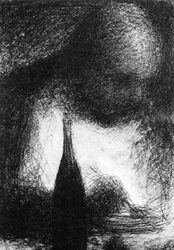Seurat
Seurat’s drawings are good examples of the principles of academic tonal drawing rearranged towards new ends.
In ‘Le Dineur’
The head is essentially a classically modelled sphere. The bottle, although closest to us is not rendered in three dimensions. A choice has been made to draw it as the darkest tone of the image.
Seurat uses traditional methods with variety in one image . Here a volume is modelled for one form and local colour is prioritised for another.
The white of the paper is preserved as the napkin, This is the lightest tone , everything else is darker.
Often in Seurat drawings just one area is preserved as the strongest light .
The hand,bowl and spoon are created with skeins of marks but still retain a sense of edge.
Lines are absent. Edges are suggested by contrasts of tone alone but Seurat does not loose control of those edges (Seurat’s early drawings are copies of line drawings by Holbein)
The cast shadow of the head merges with its modelling. The shoulder moves to a dark tone at its edge against a light tone of hte background. The background then gradates from a mid tone to a dark as it moves upwards and to the right.
A subtle game of ‘lost and found’ edges ,dissolving forms and gradual tonal changes engages the viewer.
A diagonal from bottom right to top left is made by the hand, spoon, bottle top and end of napkin.
Forms exist within a geometric structure .Objects are partially rendered individually and then reclaimed by a geometry.
The dark of the wine bottle at the bottom edge leads us in to a passage of tone up towards trhe head.
Pathways of linked tones lead in and out of the image.
